-

人教版新目标初中英语九年级下册I’ll help clean up the city parks教案
Talk about offering help (P60)I’ll help clean up the city parks.A: I’d like to work ...B: You could help ...Talk about ways to tell people about the Clean-Up Day (P61)We need to ...We can’t ...I’ll ...Talk about the work the volunteers do (P62)These three students all volunteer their time to help other people.Somebody loves to ... / helps ... / plans to ... / wants to ...A: What do you like doing?B: I like ... A: What kind of volunteer work do you think I could do?B: You could ...1. 重点词汇advertisement, fix, repair, pleasure, blind, deaf, shut, carry, specially, fetch2. 认读词汇hunger, homeless, cheer, clean-up, sign, establish, major, commitment, elementary, veterinarian, coach, similar, call-in, strategy, disabled, organization, unable, support, appreciate, donation, part of speech, pronoun, adverb, preposition, conjunction, donate, Jimmy, Sally3. 词组clean up, cheer up, give out, put off, set up, think up, take after, fix up, give away, put up, hand out, work out, at once

人教版新目标初中英语九年级下册We’re trying to save the manatees教案2篇
本单元主要围绕着有关濒临灭绝的动物这一话题,学习了应该怎样保护我们的环境,以及就某一问题展开辩论。目标提示语言目标能够运用所学知识,就某一问题展开辩论。认知目标1、复习一些语法:现在进行时、一般现在时、用used to 表示一般过去时、现在完成时、一般过去时的被动语态。2、学会表达同意和不同意。3、学会以下基本句型:We’re trying to save the manatees.Manatees eat about 100 pounds of food a day.There used to be a lot of manatees.In 1972,it was discovered that they were endangered.Some of the swamps have become polluted.情感目标了解一些濒临灭绝的动物的生活习性和濒临灭绝的原因,教育学生应该如何保护环境。教学提示充分利用多媒体等教学设备,创设与本课话题相关的情境,如各种不同种类的动物、动物园以及有关环境的画画等等。围绕着本单元的教学目标,设计一些贴近学生实际的教学任务,如让学生谈论自己最喜欢的动物,如何拯救濒危动物,如何保护环境等等。让学生根据所学知识,就动物园是否对动物有利以及其他的话题进行辩论。

人教版新目标初中英语九年级下册You’re supposed to shake hands教案
教学目标:1. 掌握本单元一些重点词汇的写法和用法。2. 学会自如谈论餐桌礼仪。Step 1 RevisionAsk some students to retell the customs at the table in France in the passage in 3a.Step 2 Self checkPart 1. Fill in each bland with the correct word given. Students do the exercises by themselves at first. Then check the answers. Ask the students to comprehend the sentences and help them point out uses of some words, like “arrive (at / in) sw., spend time / money on sth , spend time / money (in) doing sth.”Part 2. Read about Fan Ling’s experience in a western restaurant. Understand the passage. Point out some key points in the passage.1. be / get used to doing sth. 习惯做某事2. begin with = start with 以….开头3. crowd v. 挤满,塞满 the crowd 人群 crowded adj. 拥挤的Then students discuss about how she would solve her problem. Ask some to share their stories with others.Part 3. Complete the crossword by looking at the sentences on the left. Then check the answers.

人教版新目标初中英语七年级上册What time do you go to school教案
知识与能力复习词汇time,morning,breakfast,get up,g0 t0 bed,homework,clock,afternoon,lunch,run,watch TV,evening,dinner,eat,usually,o’clock,thirty,fifteen,take a shower,go t0 school等;引导学生复习、巩固“询问和谈论时间”的目标语言并运用所学知识安排自己的学习和课外活动。过程与方法运用Summarizing,Classifying和Comparing的学习策略。在复习教学中,运用听写、提问、对话演练与调查活动,促使学生不断地使用所学内容,从而提高他们灵活运用知识的能力。情感态度价值观本部分的主要内容是复习“日常作息时间”的询问和表达。通过互相询问或谈论自己或对方的作息时间安排和活动计划,培养学生良好的作息习惯和守时习惯。教学重、难点及教学突破重点复习词汇time,morning,breakfast,get up,g0 to bed,homework,clock,afternoon,lunch,run,watch TV,evening,dinner,eat,usually,o’clock,thirty,fifteen,take a shower,go to school等;引导学生复习、巩固“询问和谈论时间”的目标语言。

人教版新目标初中英语七年级下册What does he look like教案3篇
所需要用到的句子:Who is that?That is Jack. I like him.Why do you like him?I like him because he is interesting.Task 4: 设计理想中的人类Step one: 设计理想中的人类的外貌。把全班同学分成若干小组,学生可以边说边在纸上画出他们的模样。Step two: 设计理想中人类的性格。学生们可以把那些能描述性格的单词写在图画的旁边。Step three: 每组选出一名同学,其他同组同学提问,他作简单回答,并说明原因。所需用到的句子:What does he or she look like?He or she ...What is he or she like?He or she is ...Why?Because ...Task 5: 挑战性活动调查性格是天生的还是后天形成的,让每个同学回家去调查一下自己成长过程中性格是否有变化,具体是怎样的,为什么会这样? Teaching Aims:1. Enable students to have a general understanding of how to talk about people's physical appearance.2. Enable students to tackle some essential vocabularies and patterns about describing people. Provide them with necessary skills and methods.3. Create various chances for students to describe the persons they're familiar with, such as classmates, family members, teachers, idols, etc.

人教版新目标初中英语七年级下册I want to be an actor教案2篇
三、教学建议第一课时:1. Lead in (Vocabulary)A) Before class, teacher should collect some pictures of working places. For example: Bank, TV Station, Restaurant, Police Station, Hospital ...B) In class, show students the pictures (PowerPoint, OHP). Ask students to tell the name of the working places and the name of the jobs.Shop assistant, doctor, actor, reporter, police office, waiter, bank clerk, studentC) Do exercise 1a and 3a.2. Bingo GameAsk groups of students to make up pairs of cards with a job on one and the related workplace on the other. For example, waiter / restaurant, teacher / school, doctor / hospital. Encourage students to use both the job / workplace combinations in the book and the ones that students came up during class discussions. Be sure they have twice as many sets of cards as there are students in the group. They can make two sets of cards for a single job / workplace, if necessary. Then have each group mix up its set of cards and hand their cards out in random order. Each time a student gets a pair of cards that match, he or she can lay these cards down. The goal is to have no cards in your hand at the end.3. Task OneA) Ask students to work in pairs and ask the partner what does he / she want to be in the future.e. g. :What do you / does he / does she want to be?I want to be a.Why?Because it's (adj).B) Vocabulary: Section B, 1a4. Homework 1.2.

人教版新目标初中英语八年级下册Why don’t you get her a scarf教案
教师带领学生复习有关描述宠物的词汇,采用教师提问学生回答的方进行。如:T:What animals do you think would be good pets?What animals do you think would be bad pets?What do you think are good animals for a six-year-old child?然后学生进行 pairwork 练习。Task two: 师生互动,学习探究 1、播放3a部分的录音,引导学生一边听录音,一边跟读。2、通过听录音学生回答以下问题:Why do you think pot-bellied pigs are popular?What are the advantages and disadvantages of keeping such a pet?教师对学生的回答进行及时点评。3.学习范文,学习重点短语,为下步的模仿写作提供语言素材。T :1. )Have you ever kept a pig as a pet?Do you like pigs? St.:No.…Why don’t you like to keep a pig? St: No.They’re too dirty and lazy(Do you know in some foreign countries like Hollyland, Australia,pigs are the most popular pet.there’s a kind of pig.(图)it has an interesting name? it ‘s called a pot-bellied pig.) Now,let’s learn an article about this kind of interesting pet.2.)play the tapeSt.:Listen and repeat3.)show some Qs on computer(本子St.: read silently,then answerthe Qs(本子)4.)Ask ss. Close book and retell this passage.(what is a pot-bellied pig? Is it a good or bad pet? ) St.: retell it to each other“A pot –bellied pig is a popular pet now…”5.read the article together.St.:.practice reading

人教版新目标初中英语九年级上册How do you study for a test教案2篇
内容提示本单元主要内容是学会利用verb十by/with gerund表示方式方法来讨论学习英语的策略,认识自己在学习方面的长处和不足。初步了解现在完成时的结构和用法。现在完成时由助动词have/has+动词的过去分词构成,主要表示过去发生的某一动作对现在仍有影响或造成的后果,常与already,yet,just,ever,never等副词连用。教学目标一、学习目标(Language Goal) 1. Talk about how to study . 学会讨论各种学习方法和策略。2. Find out your suitable learning methods. 找出适合自己的学习方法。 二、语言结构(Language Structures) 1. Verb + by with gerund by+动名词短语 表示“通过…途径,方法” 2. How questions have引导的特殊疑问句 三、目标语言(Target Language) 1. How do you study for tests ? 你是怎样准备考试的?Well , I study by working with my classmates. 哦,我和同学们一起学习。2. Have you ever studied with a group ? 你曾经参加过学习小组吗?Yes , I have . I’ve learned a lot that way . 是的,参加过。通过这种方式我学了许多。

人教版新目标初中英语九年级上册Where would you like to visit教案2篇
The First PeriodⅠ.Teaching Aims and DemandsKnowledge Objects(1) Key Vocabularytiring, educational, fascinating, thrilling, peaceful, exotic, trek, jungle, take it easy, explore, historic, site(2) Target LanguageWhere would you like to go on vacation?I’d like to trek through the jungle, because I like exciting vacations.2. Ability Objects(1)Train students to talk about places they would like to visit with the target language.(2)Train students to describe vacations with different adjectives.(3)Train students' listening skill.3. Moral Object,It′s more interesting to go on vacating somewhere instead of staying at home.Ⅱ. Teaching Key Points1. Key Vocabularytiring, educational, fascinating, thrilling, peaceful, exotic, trek, jungle, take it easy, explore, historic, site2. Target LanguageTalk about different places with the target language.Ⅲ. Teaching Difficult Points1. Describe vacations with different adjectives.2. Talk about different places with the target language.Ⅳ. Teaching Methods1. Teaching by illumination2. Teaching by doing chain drills3. Teaching by pairworkⅤ. Teaching Aids1. A tape recorder2. Some pictures of different places with famous views
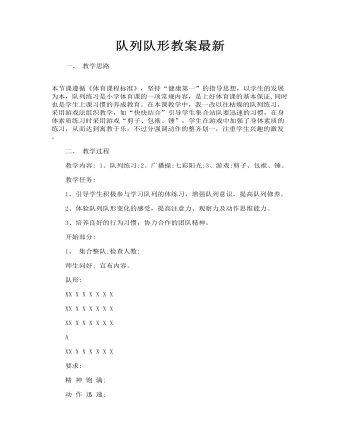
队列队形教案最新
二、 教学过程 教学内容: 1、队列练习;2、广播操:七彩阳光;3、游戏:剪子、包袱、锤。 教学任务: 1、引导学生积极参与学习队列的体练习,增强队列意识,提高队列修养。 2、体验队列队形变化的感受,提高注意力、观察力及动作思维能力。 3、培养良好的行为习惯,协力合作的团队精神。
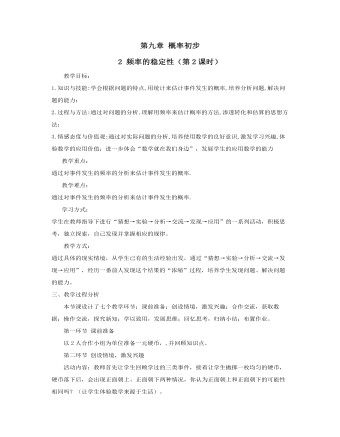
频率的稳定性教案教学设计
活动内容:教师首先让学生回顾学过的三类事件,接着让学生抛掷一枚均匀的硬币,硬币落下后,会出现正面朝上、正面朝下两种情况,你认为正面朝上和正面朝下的可能性相同吗?(让学生体验数学来源于生活)。活动目的:使学生回顾学过的三类事件,并由掷硬币游戏培养学生猜测游戏结果的能力,并从中初步体会猜测事件可能性。让学生体会猜测结果,这是很重要的一步,我们所学到的很多知识,都是先猜测,再经过多次的试验得出来的。而且由此引出猜测是需通过大量的实验来验证。这就是我们本节课要来研究的问题(自然引出课题)。

家长学校教案 家庭教育的作用
(2)依托各方力量,办好家长学校 学校要重视家长学校这块教育主阵地的建设。首先成立家长学校领导机构——家长委员会,做到定期召开家长委员会会议,通报学校工作计划及取得的成绩、听取家长委员会成员的合理化建议等。依托家长委员会,组织专题研讨,为家校沟通、亲子沟通提供平台。同时从家庭教育的视角,与家长们一起思考如何提高教育的有效性。 为加强教育的效果,一方面学校要求教师访问学生家庭,作好了解、协调工作,防微杜渐。另一方面,还要通过家长学校这种组织机构治标治本,对学生家长有针对、有系统、分层次地进行家庭教育的辅导,通过家长会、辅导讲座、交流会、家长信、校刊小报等多种途径和手段,帮助家长树立正确、新型的家庭教育观念,传授家长科学、合理的育人常识和技巧,提高家庭教育水平。
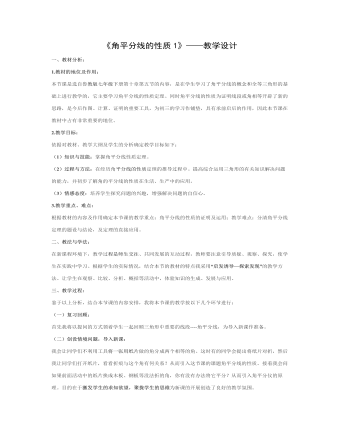
角平分线的性质教案教学设计
这是本节课的重点。让同学们将∠aob对折,再折出一个直角三角形(使第一条折痕为斜边),然后展开,请同学们观察并思考:后折叠的二条折痕的交点在什么地方?这两条折痕与角的两边有什么位置关系?这两条折痕在数量上有什么关系?这时有的同学会说:“角的平分线上的点到角的两边的距离相等”.即得到了角平分线的性质定理的猜想。接着我会让同学们理论证明,并转化为符号语言,注意分清题设和结论。有的同学会用全等三角形的判定定理aas证明,从而证明了猜想得到了角平分线的性质定理。
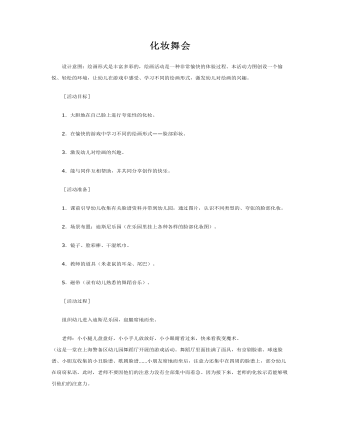
大班美术教案:化妆舞会
1.大胆地在自己脸上进行夸张性的化妆。2.在愉快的游戏中学习不同的绘画形式——脸部彩妆。3.激发幼儿对绘画的兴趣。4.能与同伴互相帮助,并共同分享创作的快乐。 [活动准备]1.课前引导幼儿收集有关脸谱资料并带到幼儿园,通过图片,认识不同类型的、夸张的脸部化妆。2.场景布置:迪斯尼乐园(在乐园里挂上各种各样的脸部化妆图)。3.镜子、脸彩棒、干湿纸巾。4.教师的道具(米老鼠的耳朵、尾巴)。5.磁带(录有幼儿熟悉的舞蹈音乐)。
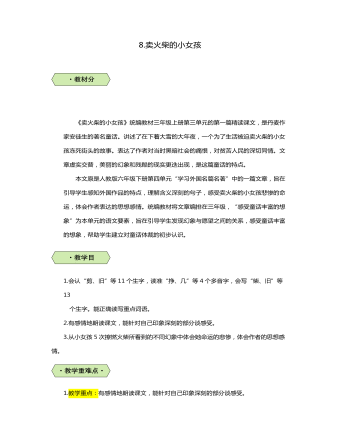
三年级语文卖火柴的小女孩教案
《卖火柴的小女孩》统编教材三年级上册第三单元的第一篇精读课文,是丹麦作家安徒生的著名童话。讲述了在下着大雪的大年夜,一个为了生活被迫卖火柴的小女孩冻死街头的故事。表达了作者对当时黑暗社会的痛恨,对贫苦人民的深切同情。文章虚实交替,美丽的幻象和残酷的现实更迭出现,是这篇童话的特点。本文原是人教版六年级下册第四单元“学习外国名篇名著”中的一篇文章,旨在引导学生感知外国作品的特点,理解含义深刻的句子,感受卖火柴的小女孩悲惨的命运,体会作者表达的思想感情。统编教材将文章编排在三年级,“感受童话丰富的想象”为本单元的语文要素,旨在引导学生发现幻象与愿望之间的关系,感受童话丰富的想象,帮助学生建立对童话体裁的初步认识。
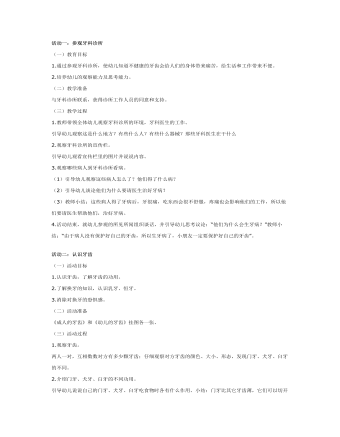
大班健康系列活动教案:我的牙齿
(二)教学准备 与牙科诊所联系,获得诊所工作人员的同意和支持。 (三)教学过程 1.教师带领全体幼儿观察牙科诊所的环境,牙科医生的工作。 引导幼儿观察这是什么地方?有些什么人?有些什么器械?那些牙科医生在干什么 2.观察牙科诊所的宣传栏。 引导幼儿观看宣传栏里的图片并说说内容。 3.观察哪些病人到牙科诊所看病。 (1)引导幼儿观察这些病人怎么了?他们得了什么病? (2)引导幼儿谈论他们为什么要请医生治好牙病? (3)教师小结:这些病人得了牙病后,牙很痛,吃东西会很不舒服,疼痛也会影响他们的工作,所以他们要请医生帮助他们,治好牙病。 4.活动结束,就幼儿参观的所见所闻组织谈话,并引导幼儿思考议论:“他们为什么会生牙病?”教师小结:“由于病人没有保护好自己的牙齿,所以生牙病了,小朋友一定要保护好自己的牙齿”。

大班健康活动:食物的旅行教案
活动目标: 1、让幼儿了解各消化器官的功能和食物在人体内消化吸收过程2、学习简单的自我保护方法3、培养幼儿良好的饮食和卫生习惯活动准备: (1)电脑制作《小豆子的旅行》(或图片及小豆子旅行的故事录音)(2)健康知识卡片、消化图、自制健康行为棋活动过程:
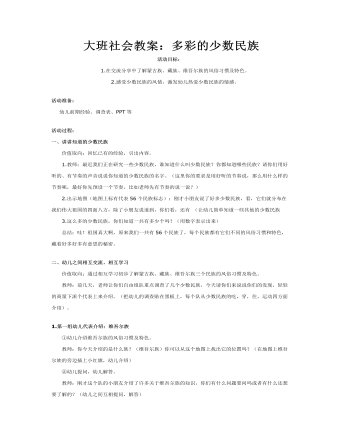
大班社会教案:多彩的少数民族
活动准备: 幼儿前期经验、调查表、PPT等活动过程:一、讲讲知道的少数民族 价值取向:回忆已有的经验,引出内容。1.教师:最近我们正在研究一些少数民族,谁知道什么叫少数民族?你都知道哪些民族?请你们用好听的、有节奏的声音说说你知道的少数民族的名字。(这里你的要求是用好听的节奏说,那么用什么样的节奏呢,最好你先预设一个节奏,比如老师先有节奏的说一说?)2.出示地图(地图上标有代表56个民族标志):刚才小朋友说了好多少数民族,看,它们就分布在我们伟大祖国的四面八方,除了小朋友说道到,你们看,还有(让幼儿简单知道一些其他的少数民族3.这么多的少数民族,你们知道一共有多少个吗?(用数字表示出来) 总结:哇!祖国真大啊,原来我们一共有56个民族了,每个民族都有它们不同的风俗习惯和特色,藏着好多好多有意思的秘密。
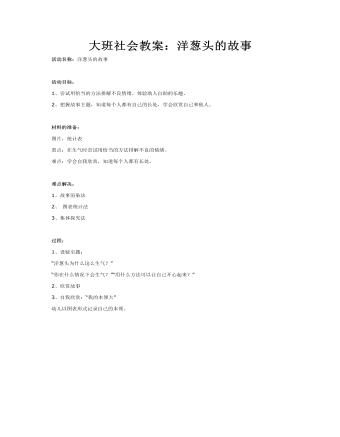
大班社会教案:洋葱头的故事
活动目标:1、尝试用恰当的方法排解不良情绪,体验助人自助的乐趣。2、把握故事主题,知道每个人都有自己的长处,学会欣赏自己和他人。 材料的准备:图片,统计表重点:在生气时尝试用恰当的方法排解不良的情绪。难点:学会自我欣赏,知道每个人都有长处。
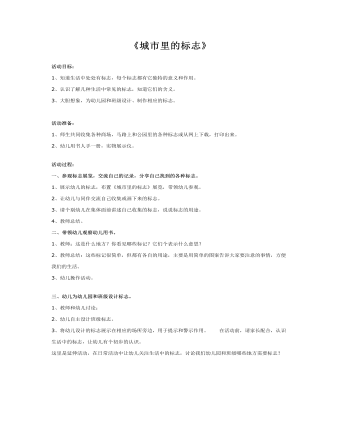
幼儿园大班社会教案:城市的标记
活动准备:1、师生共同收集各种商场,马路上和公园里的各种标志或从网上下载,打印出来。2、幼儿用书人手一册,实物展示仪。活动过程:一、参观标志展览,交流自己的记录,分享自己找到的各种标志。1、展示幼儿的标志,布置《城市里的标志》展览,带领幼儿参观。2、让幼儿与同伴交流自己收集或画下来的标志。3、请个别幼儿在集体面前讲述自己收集的标志,说说标志的用途。4、教师总结。